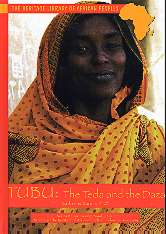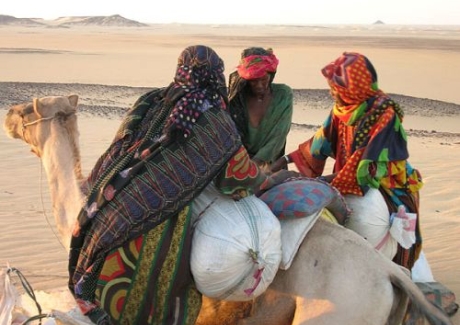The Garri people divide into two main sub-tribes which is Tuuf and Quran (Quranyowa). It is said that the president of Chad came to a refugee camp in Somalia where the Garri people were displaced after the Ogaden war. Hissene Habre of Chad supposedly met with Garri elders in the 1980′s and told them of the existence of Garris (Tuuf and Quran) in his country. In chad, Tuuf is known as Toubou and Quran is known as Gorane.

At a time when Africa was new to independence, the instability, political divisions, and power struggles could be felt throughout the Horn of Africa. Colonial Somalia, Kenya and Ethiopia, are the lands where the Garris lived. The colonialist left the borders for the natives to govern without any tools or organization pre-established for them. After the departure of Colonialism, the new leaders called it upon themselves to establish an identity for their newly acquired borders. Those who spoke Somali created the Somali Nationality. The Garris in Ethiopia meanwhile dealt with oppression not from foreign entities but leaders of their own nation. Those who spoke Oromo created their own nationality which separated itself, and stood as a rebel group against the oppressions of the Ethiopian Government under the rule of Mengistu Haile Mariam and Haile Selassie. The Garris who spoke both of these languages are later given the option to choose which nationality they wish to be a part of. The elders at the time, chose to be part of the somali ethnicity. This option has caused a massive ripple in the understanding and establishing of a Garri identity. Garris of Ethiopia did not speak Somali and did not want to be part of the Somali ethnicity. This is where this blog comes in. Are Garris Somali, or Oromo? Both of these ethnicities are established through politics to create a nationality which fits a particular interest. Somalia is built to create a “greater Somalia” which expands into Ethiopia and Garris are offered to be part of this so they can be of use to this mission. The Oromo ethnicity is established to eradicate the oppression inflicted by the Ethiopian government upon minorities who speak “Oromo”. If this claim of Garris in Chad was actually made by the former president, there is a possibility that there might be a political agenda behind it. But on the other hand, the possibility of truth behind the claim cannot be completely disregarded.
 A girl from the semi-nomadic Garri tribe, of southern Ethiopia, peers out from her headscarf, at the Walde Refugee Camp, in northern Kenya. 1993.
A girl from the semi-nomadic Garri tribe, of southern Ethiopia, peers out from her headscarf, at the Walde Refugee Camp, in northern Kenya. 1993.
All of the information printed about Garri people in more recent years has labeled Garris as Somalis. The picture above says “Garri tribe of Southern Ethiopia”. Contradiction is the common theme on Garri “nationality” or ethnicity. Sometimes It’s Garri tribe of Ethiopia and sometimes it’s Garri Somali tribe.

A toubou woman holding her baby. The physical features of Toubou (Gorane) people are very similar to that of the Garri people as seen in this picture. The item she is holding in her hand, resembles the “idhina” used by Garri people to burn incense.
 The Garri amber necklace, on a Toubou woman.
The Garri amber necklace, on a Toubou woman.

Similarity in the way the woman dress.
The Toubou and Gorane people of chad live a nomadic lifestyle and value camels, just as the Garri of East Africa.

About these ads
9 khalaf
10 moalin omar
11 Isow
12 Barre
13
Kilmaale
14 Furkesha
15 Quranyow
16 Mohamed
17 Mahe
18 Dir
i
know you have the children of Furkesha in your site but that doesn't
include our name Kilmaale Furkesha... i have looked all over the
internet but i didn't find any info about kilmaale... so i started to
think that since our people migrated from the quranyow in northern
kenya down to bay region, it could have been lost in pronunciation
because it was such a long time that even today we are part of a
completely different tribe but we still remember our abtirsi. give me
your thoughts on this if you have any info regarding this.
Bah ???
Walaalo isku bah ah
- Assaree
Quran Maxamed
i know quranyow are garre and they live both in northern kenya and
shabeelaha hoose in somalia.... we are in the Hariin clan of
rahanweyn/Mirifle and settle near baidoa a places called, labaatan
jarow, goof gaduud, busul, mooro waraabe... so we basically dont even
claim or know much about our garre/quranyow/dir side... these days we
are basically just Hariin.. however i have always heard our elders
talking about that such a long time ago our people were defeated by
the oromo and boran in nothern kenya and pushed towards southern
somalia... and most of them moved to settle near the river shabelle
whereas our group decided to settle near baidoa and joined the Hariin
sub clan which we have since mixed, married with and are now fully
rahanweyn and the only thing connecting us to quranyow now is our
abtirsi.... sow just out of curiosity james, how does a European get
into somali clan systems and now is an expert lol tell me a little
about that if you don't mind plz its interesting... i say this
because couple of years ago when i first came to England as teenager
and was going to college i asked some of my English friends what
their clans were looool which they hilariously laughed at and made so
many jokes about me since then.. to me at the time, it was strange
that they didn't belong to no tribes and they were lucky if they knew
their great grandfather's name lol sorry about long post
According to the Gharri’s oral traditional history and
British colonial era records based on interview they had with then
Gharri elders, regarding the origin of the Gharri people, the Gharri
people came from red sea coast and settled at “Serar”, what is
now known as arusi province of Ethiopia, They build mosques and homes
made of stones. Then during the 1600th exodus of people’s movement,
from the north reached the Gharri kingdom and fighting ensued because
the enemies started looting the Gharri properties and herds. The
Gharri were outnumbered and they were forced to immigrate toward
southwest, and settled around filtu and Wachile areas.
The Gharri
traditional historians state that the Gharri lived there for period
of about 60 years without any disturbances. During that time they
build stone houses and mosques around filtu and wachile especially
around the dawa riverbanks in around fifty miles corridors from Malka
Mari through Malka Dirir area.as it were a standard way of building
houses. Then later on the exodous of the Borana reached there. It was
believed that was the first time they came in contact with the
Borana
So, during late 1600 and early 1700, they lived with
the Borana. Later on, things changed, and the Gharri were outnumbered
by the Boran and the Borana tried to make them subjects and demand
tribute. So, the Gharri decided to move back to their previous region
of Confur through Juba land.
https://en.wikipedia.org/wiki/Seraro
The "exodus
from the north" is Darod Somalis from the Sultanate of Adal out
of Ethiopia, specifically Ifat, which had been invaded by Amhara and
Oromos, which forced Garre (of whom your ancestors were in the Garre
confederation at the time) to leave their lands in Serar (Seraro in
Oromo, it's a Woreda
https://en.wikipedia.org/wiki/Seraro)
and migrate to Wuchale in northern Kenya.
According to the
Gharri they chose to leave on their own after pressure from the
Borana grew too great, though who knows, anyways they crossed over
the Jubba into Konfur. After this, one branch of the Gharri decided
to go back and reclaim their lands, but presumably your ancestors
decided to stay behind and join the Raxanweyn.
The bit about
being originally from the Red Sea Coast is probably close to true,
though probably not the coast but rather the interior near Harar.

 A girl from the semi-nomadic Garri tribe, of southern Ethiopia, peers out from her headscarf, at the Walde Refugee Camp, in northern Kenya. 1993.
A girl from the semi-nomadic Garri tribe, of southern Ethiopia, peers out from her headscarf, at the Walde Refugee Camp, in northern Kenya. 1993.



